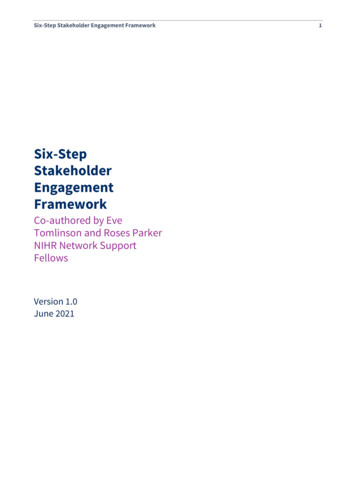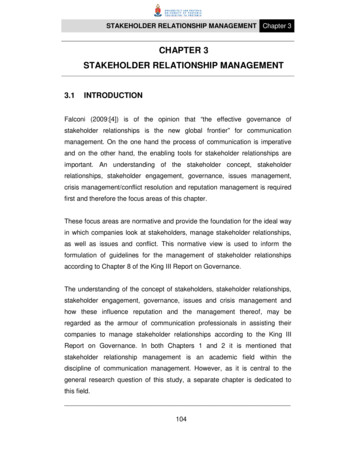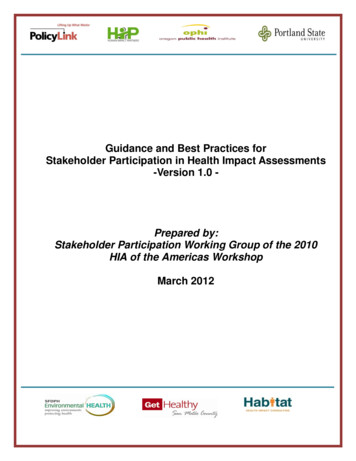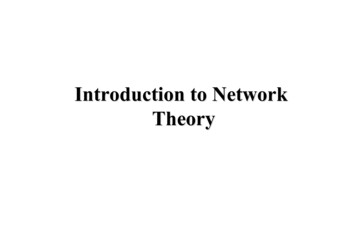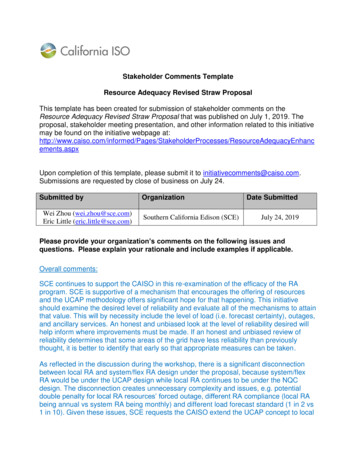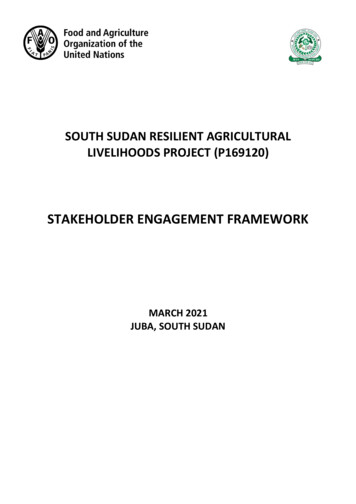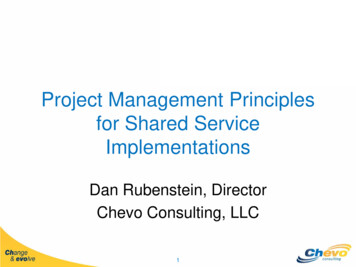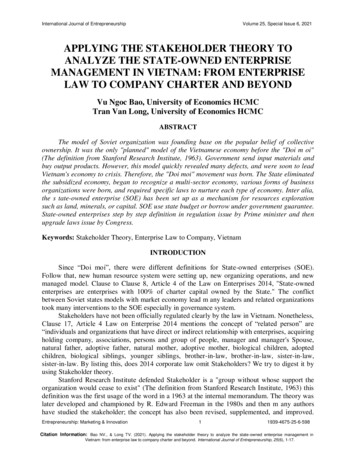
Transcription
International Journal of EntrepreneurshipVolume 25, Special Issue 6, 2021APPLYING THE STAKEHOLDER THEORY TOANALYZE THE STATE-OWNED ENTERPRISEMANAGEMENT IN VIETNAM: FROM ENTERPRISELAW TO COMPANY CHARTER AND BEYONDVu Ngoc Bao, University of Economics HCMCTran Van Long, University of Economics HCMCABSTRACTThe model of Soviet organization was founding base on the popular belief of collectiveownership. It was the only "planned" model of the Vietnamese economy before the "Doi m oi"(The definition from Stanford Research Institute, 1963). Government send input materials andbuy output products. However, this model quickly revealed many defects, and were soon to leadVietnam's economy to crisis. Therefore, the "Doi moi" movement was born. The State eliminatedthe subsidized economy, began to recognize a multi-sector economy, various forms of businessorganizations were born, and required specific laws to nurture each type of economy. Inter alia,the s tate-owned enterprise (SOE) has been set up as a mechanism for resources explorationsuch as land, minerals, or capital. SOE use state budget or borrow under government guarantee.State-owned enterprises step by step definition in regulation issue by Prime minister and thenupgrade laws issue by Congress.Keywords: Stakeholder Theory, Enterprise Law to Company, VietnamINTRODUCTIONSince “Doi moi”, there were different definitions for State-owned enterprises (SOE).Follow that, new human resource system were setting up, new organizing operations, and newmanaged model. Clause to Clause 8, Article 4 of the Law on Enterprises 2014, "State-ownedenterprises are enterprises with 100% of charter capital owned by the State." The conflictbetween Soviet states models with market economy lead m any leaders and related organizationstook many interventions to the SOE especially in governance system.Stakeholders have not been officially regulated clearly by the law in Vietnam. Nonetheless,Clause 17, Article 4 Law on Enterprise 2014 mentions the concept of “related person” are“individuals and organizations that have direct or indirect relationship with enterprises, acquiringholding company, associations, persons and group of people, manager and manager's Spouse,natural father, adoptive father, natural mother, adoptive mother, biological children, adoptedchildren, biological siblings, younger siblings, brother-in-law, brother-in-law, sister-in-law,sister-in-law. By listing this, does 2014 corporate law omit Stakeholders? We try to digest it byusing Stakeholder theory.Stanford Research Institute defended Stakeholder is a "group without whose support theorganization would cease to exist" (The definition from Stanford Research Institute, 1963) thisdefinition was the first usage of the word in a 1963 at the internal memorandum. The theory waslater developed and championed by R. Edward Freeman in the 1980s and then m any authorshave studied the stakeholder; the concept has also been revised, supplemented, and improved.Entrepreneurship: Marketing & Innovation11939-4675-25-6-598Citation Information: Bao NV., & Long TV. (2021). Applying the stakeholder theory to analyze the state-owned enterprise management inVietnam: from enterprise law to company charter and beyond. International Journal of Entrepreneurship, 25(6), 1-17.
International Journal of EntrepreneurshipVolume 25, Special Issue 6, 2021Stakeholder formed in the process of enterprise planning, systems theory, organization theory,and corporate social responsibility (SRI, 1963). Stakeholder was first mentioned in the 1950s bythe authors: (Russell Ackoff & Charles, 1957) and was supplemented by (Ian I. Merroff &Richard O. Mason, 1983) forming the concept of "The interesting parties are those who dependon the organization / agency to realize some of their goals, and vice versa, the organization alsodepends in part on them to fully accomplish their goals”.Using the theory of Stakeholders compared with SOE Stakeholder disclosure, it can beshown that: There exists an existence of Stakeholders who can directly intervene in the SOEpersonnel management system that is not prescribed by law. Specified, the enterprise does notpublish. This leads to Investors, especially foreign investors, who do not have enoughinformation to make investment decisions. Investments may not optimize profits or losses.Government invested in SOE, but result did not meet expectations. Many large projects wereineffective (Such as Ninh Binh fertilizer factory, Dinh Vu fiber factory, Dung Quat shipyard).Many business leaders were to face court. (Such as Ninh Binh fertilizer factory, Dinh Vu fiberfactory, Dung Quat shipyard). Vietnam has just lost money and human resource, but moreimportant has lost its confidence in the Party's policies and state's laws.In fact, once the government regulates the law will make the number of Stakeholderschange. But, Clause 17, Article 4 of the Enterprise Law 2014 on related persons, Partyorganizations are mentioned. Then of course many Stakeholders will be missing. Partyorganizations are an exampleHowever, in the provisions of Clause 17, Article 4 of the Enterprise Law 2014 on relatedpersons, Party organizations, or the Politburo are not mentioned. Therefore, in corporategovernance announcement, SOE also does not announce the role of party organizationsThese results ask us to study about affected of the role of Stakeholders in the success orfailure of corporate governance especially in human resource management.Are there any hidden Stakeholders? How are they affected to human resource in SOEs?What are the reforms that help Stakeholders interfere to SOEs to make things better?So, apply Stakeholder theory to identify any missing Stakeholders that may affect yourbusiness, analyzing the role of key Stakeholders. Then conduct interviews with experts and SOEleaders to confirm finding. Using some case that stakeholders interfere to human resource systemas example.The expectations analysis points to the relationships between different Stakeholders withSOE that are not yet specified in the legal documents. Somehow these connections are hidden tomake decisions that the rest of the party can hardly predict. This may cause remainingunnecessary.Analyze practical situations to manifest the influence of Stakeholders. From the researchresults, recommendations are made for the management of Stakeholders to help SOEs work moreeffectively.STAKEHOLDER THEORY AND BUSINESS MANAGEMENTStakeholders TheoryStakeholders formed in “the business planning process, theory of systems, theory oforganization, and social responsibility of enterprises” (SRI, 1963). The stakeholder was firstmentioned in the 1950s (Russell Ackoff & Charles, 1957). After that it was supplemented by(Ian I. Merroff & Richard O. Mason, 1983) “The Stakeholders are Stakeholders. Depends on theEntrepreneurship: Marketing & Innovation21939-4675-25-6-598Citation Information: Bao NV., & Long TV. (2021). Applying the stakeholder theory to analyze the state-owned enterprise management inVietnam: from enterprise law to company charter and beyond. International Journal of Entrepreneurship, 25(6), 1-17.
International Journal of EntrepreneurshipVolume 25, Special Issue 6, 2021organization / agency to realize some of their goals, and on the contrary, the organization alsodepends in part on them to fulfill its goals.” (Mendelow, 1981) built a model of stakeholderanalysis based on power and entitlement, thereby allocating responsibilities for appropriatemonitoring and supervision of each different Stakeholders.(Freeman, 1984) expands stakeholder under the influence of many fields. He definesstakeholder "as a person or group of people who are directly or indirectly influenced by theactions of an organization". This interest can also be described as those who are affected by orwho can affect a decision or actions (Freeman et al., 2017; Ronald et al., 1997). There are alsostudies by (Donaldson & Preston, 1995) “the stakeholder theory has been advanced and justifiedin the management literature. One on the basis of its descriptive accuracy, instrumental power,and normative validity. These three aspects of the theory, although interrelated, are quite distinct;they involve different types of evidence and argument and have different implications”.Moreover (Ronald et al., 1997) has developed and “contribute to a theory of stakeholderidentification and salience based on stakeholders possessing one or more of three relationshipattributes: power, legitimacy, and urgency. By combining these attributes, we generate atypology of stakeholders, propositions concerning their salience to managers of the firm, andresearch and management implications”.Then “employ stakeholder theory to propose how perceptions of fairness result inreciprocity and extending to all stakeholders of the firm and affecting firm performance”. Thegroup (Edward Freeman & Robert Phillips, 1984-2010), found that there were manycontradictions among the stakeholders, the authors argued that the tensions were more obviousthan reality, representing the various stories of stakeholder theory, SM, especially especiallyprofitability needs in business and ethics. The authors tried to understand the differences in thesetwo theoretical positions because they sought to solve different problems. However, the authorshave distinguished the overlapping areas and instead, we think that some of the tensions may,instead, provide interesting ways to place two areas of scholarship and realism. Opinion together.But group of authors (Margit Huber & Martina Pallas, 2006) point out that “Nowadays, theconcept of stakeholder management is no longer limited to the specific focusing of all corporateactivity on interest groups, such as customers, employees, shareholders or suppliers, but hasbecome an integral part of a company’s daily action. Measuring the quality of relationshipsbetween companies/institutions and the relevant interest groups, developing actions aimed atimproving these relationships (managing) and the continuous monitoring of the effects in linewith the TRI*M (TRI*M is the name of the customer retention system introduced to the marketin the early 1990s) The TRI*M-Systems has been developed to measure, manage, and monitorcustomer relationships approach, is gaining momentum in all areas and at all levels of companiesand ins- tuitions. Today, human resources departments usually measure the comment ofemployees in all organizational units on an annual basis, and senior managers develop strategieswith their employees to the level of commitment, the success of which will ultimately bereviewed through subsequent measuring. This greater focus on employee commitment has onlyrecently been given priority. For a long time, companies have failed to appreciate that themotivation and engagement of employees is the most important basis for excellent customerexperiences and, consequently, profitability. Only engaged and motivated employees will use alltheir skills and energies for the benefit of the company.” So this theory is mentioned about thehuman resource, manager need to engage and motivated them.(Macdonald, 2008) this investigation of the impact stake holder such as hierarchy of fivecrisis communication accounts and four crisis causes on multiple stakeholder reactions elicitedEntrepreneurship: Marketing & Innovation31939-4675-25-6-598Citation Information: Bao NV., & Long TV. (2021). Applying the stakeholder theory to analyze the state-owned enterprise management inVietnam: from enterprise law to company charter and beyond. International Journal of Entrepreneurship, 25(6), 1-17.
International Journal of EntrepreneurshipVolume 25, Special Issue 6, 2021several key findings. Although “confession” was the most preferred crisis account, “nocomment” was almost as successful in mitigating negative reactions. Counter intuitively,confession reduced responsibility judgments. No comment was second to confession inmitigating negative, and promoting positive, reactions. Further, company control of a crisis wasfound to be the single most powerful predictor of stakeholder reactions. Involvement elicitedmultiple positive and negative crisis emotions, while different emotion categories eliciteddifferent behavioral intentions. Attitude to the company also impacted behavioral intentions.(Farrokh Suntook & John Murphy, 2009) investigation in how “stakeholder reactions tocompany crisis communication and causes”. This paper has pointed out that the company'scontrol over a crisis is considered the most powerful predictor of stakeholder reactions.Participation has evoked many positive and negative crisis emotions, while different types ofemotions evoke different behavioral intentions. Attitudes toward the company also influenceintent to behavior; Source: Kaufmann onion stakeholder, 2014 Figure 1.FIGURE 1STAKE HOLDERS THEORYIn general, stakeholders can be grouped in several ways, such as “who is concerned, whofinally makes decisions, who works and benefits, and who is actively collaborating”.(Edward Freeman et al., 2017) advice to find out every stakeholder, to prevent the conflictbetween stakeholder we have to find out the overlap and how there are large areas of overlap,and so some of the tensions could, instead, provide interesting special ways to put the both sideand two areas with each other and then maintain stakeholder theory could help benefit to each ofcompany or group organization from a more pragmatist philosophy the theory is increasinglybeing improved and supplement.In theory, stakeholders have been developed and fostered over time. Most studies haveshown that organizations or business companies need to invest in getting to know thestakeholders, the drivers of that organization's success or failure. From the research results, itwill help the organization to have appropriate measures to limit the negative impacts of relatedparties and promote weaknesses, positive impacts to promote the success of the company ororganization. If understand clear about the stakeholder will be help an organization have suitablestrategy to increase benefit and reduce risk. Mendelow (1981) using model apply inEnvironmental Scanning - The Impact of the Stakeholder Concept. This analyst helps to haveEntrepreneurship: Marketing & Innovation41939-4675-25-6-598Citation Information: Bao NV., & Long TV. (2021). Applying the stakeholder theory to analyze the state-owned enterprise management inVietnam: from enterprise law to company charter and beyond. International Journal of Entrepreneurship, 25(6), 1-17.
International Journal of EntrepreneurshipVolume 25, Special Issue 6, 2021suitable plan with stakeholder.He separates and allocates to a stakeholder on the grid corner shows the actions need to take tomaintenance with them:In the corner which has high power and highly interested people should manage andclosely: Must fully engage with these group people and make the best efforts to satisfy them.In the corners which have high power, less interested people must keep Satisfied: shouldput enough work with these people and then keep them satisfied, if not so much can make thembecome bored with your message.In the corner which has low power and highly interested people should keep informed:with group of these people, should inform and talk to them make sure that everything keep inorder and no major issues are arising. These group in this category can often useful and canhelpful with the detail issue of your project.In the corner of low power, less interested people should monitor: These group of people,should be maintenance and monitor but should not have bored them with excessivecommunication; Source: R. Edward Freeman. (1984): Environmental Scanning - The Impact ofthe Stakeholder Concept Figure 2.FIGURE 2POWER vs. INTERESTSTAKEHOLDERS IN BUSINESS MANAGEMENTAccording to organizational theory, an organization cannot function effectively withoutunderstanding its environment and its Stakeholders. That is the economic, political, social, legalenvironment, the relationship between the parties involved in it, and especially the interactionbetween related parties with each other and with the organization.In strategic planning, the most important thing an organization / organization need to do isto analyze Stakeholders. A key factor in the success of public or nonprofit organizations is theability to meet and satisfy key Stakeholders.If the organization / project do not understand who the stakeholder is, what criteria theyuse to evaluate their organization, and how the organization meets those criteria, it is difficult toknow how to meet the criteria.Entrepreneurship: Marketing & Innovation51939-4675-25-6-598Citation Information: Bao NV., & Long TV. (2021). Applying the stakeholder theory to analyze the state-owned enterprise management inVietnam: from enterprise law to company charter and beyond. International Journal of Entrepreneurship, 25(6), 1-17.
International Journal of EntrepreneurshipVolume 25, Special Issue 6, 2021An important objective of Stakeholder analysis is to see the overall and accurate picture ofactors in the operating environment.“Good governance will ensure the sustainability of a developed country, and goodgovernance needs a transparent, predictable institution of stakeholder on private and publicbusinesses. In the open and policymakers, a machine with professional ethics, professional work,a civil society participate in governance dramatically, and then detrainment experience religiouslaw " (WB, 1994). So, if we would like to have good result of managed, we need to managed thestakeholder.We offer the stake holder as following diagram, but not limited this Figure 3.FIGURE 3BUSINESS AND STAKEHOLDER FLOW DIAGRAMFreeman (1984) introduced strategic management stakeholders to address the legal socialroles and obligations of businesses, and he opposed the monopoly's focus on atomic companies.Profit in orthodox theories. Stakeholder theory provides an alternative normative basis, payingattention to the interactions of businesses with all stakeholders influenced or influenced by anorganization (Freeman, 1994). The standard SHT clarifies the neglected impact of externalfactors on a solid environment and broadly debates the role of stakeholders.(Freeman, 1994). However, it lacks stakeholder consideration. The obligation of the relatedparty or potential contributors to be able to convey the value created by a company. While thenormative SHT provides little management involvement, its tool partner (Donaldson & Preston,1995) tries to create a business case to invest in management. Stake holders by investigating itsinfluence on firm performance. Although in combination, they include the relevant old peopleand the company's perspective, but the stakeholder according to rules and tools is still'unidirectional'However, Stakeholder scholars recognize the need to converge on both points of view, sonew publications try to illustrate the right way of doing the stakeholder contribution to theadvantage. Competition the newer document on stakeholder management has moved the basisfor its arguments from stakeholder rights to the potential value of managing stakeholdersustainability and avoiding a conflict of interest. Defensive discussion regarding rights andobligations. A more fundamental contribution in this respect is the introduction of a systemEntrepreneurship: Marketing & Innovation61939-4675-25-6-598Citation Information: Bao NV., & Long TV. (2021). Applying the stakeholder theory to analyze the state-owned enterprise management inVietnam: from enterprise law to company charter and beyond. International Journal of Entrepreneurship, 25(6), 1-17.
International Journal of EntrepreneurshipVolume 25, Special Issue 6, 2021focused stakeholder management (Ronald et al., 1997): Managers may want to have anexhaustive list of all both stakeholders. Unlike the stakeholder view of management, theapproach focuses on this system to manage stakeholders, paying attention to the tradeoffsbetween stakeholder and organizational goals and do not consider them essentially when tryingto mediate them. Instead, the system-centered approach says that the goals of the company andits stakeholders should be aligned, that they can work towards a common goal, like a system.However, studies show that stakeholders are not limited to the above list, but because theymobilize and change, they can add or remove stakeholders.STAKEHOLDERS IN STATE OWNED ENTERPRISE:Corporate entity led to a split in 'control' and 'ownership' Limited liability for shareholders led to protection for third parties - Company Law - GovernancerequirementsEvolved from autocratic institutions to more participativeImportance of Stakeholders recognizedLatest thinking encapsulated in notion of sustainability or the triple bottom lineThere are no provisions on related parties in the 2014 enterprise law but there areregulations on related parties in Clause 17, Article 4 as follows:“Related persons are organizations and individuals that have direct or indirect relationshipwith enterprises in the following cases: The parent company, the managers of the parent company and the person competent to appoint suchmanagers for subsidiaries of the corporate group.Subsidiary regarding the parent company in the corporate group.The person or group of people capable of dominating the decision making or operation of that enterprisethrough the enterprise management agency.Enterprise managers.dd) Spouse, natural father, adoptive father, natural mother, adoptive mother, biological children, adoptedchildren, siblings, siblings, brother-in-law, brother-in-law, sister-in-law, sister-in-law of the company'smanager or of members or shareholders owning contributed capital or controlling shares;Individuals authorized to represent persons and companies defined at Points a, b, c, d and dd of this Clause.Enterprises in which the persons and companies defined at Points a, b, c, d, dd, e and h of this Clausepossess ownership so much that govern the decision-making of the management agencies at the enterprise.that karma.Group of people who agree to work together to acquire capital contributions, shares or interests in thecompany or to dominate the decision making of the company”.STATE OWNED ENTERPRISE MANAGEMENT IN VIETNAM: THE LAW, THECHARTER AND REGULATIONSState Owned Enterprise in the Law: The Role of the State in ManagementIn Clause 1, Article 51 of the 2013 constitution, “Vietnam's economy is a socialist-orientedmarket economy with many forms of ownership and many economic sectors; State economyplays a key role". So, the water Vietnam remain state-oriented economy is driven, this is also thebasis for many policies developed state sector was born. Agencies from central to local levelsform and develop state-owned enterprises.Entrepreneurship: Marketing & Innovation71939-4675-25-6-598Citation Information: Bao NV., & Long TV. (2021). Applying the stakeholder theory to analyze the state-owned enterprise management inVietnam: from enterprise law to company charter and beyond. International Journal of Entrepreneurship, 25(6), 1-17.
International Journal of EntrepreneurshipVolume 25, Special Issue 6, 2021Clause 8, Article 4 of the 2014 Enterprise Law states that “a State enterprise is anenterprise with 100% of charter capital owned by the State” stipulating the percentage of thiscapital contribution varies through other changes to the law on other enterprises. Togetherhowever, many enterprises are joint-stock companies listed on the state stock market holding lessthan 100% of the capital but still capable of controlling the operation of these enterprises throughthe ownership ratio of over 51% or voting rules on business strategy or business developmentgoals.The 2014 Enterprise Law provides for SOEs in chapter IV from Article 88 to Article 109.Pursuant to Article 89 of the 2014 Enterprise Law stipulating the organizational structureof state-owned enterprises and Article 78 of 2014 corporate law 2014 The organizationalstructure of a one-member limited liability company due to The organization as the owner of theauthor shall formulate a model of organization of management of a State enterprise as followsFigure 4:FIGURE 4A MODEL OF ORGANIZATION OF MANAGEMENT OF A STATE ENTERPRISET swine articles 90 and 91 corporate law 2014, council members represent the unit'smanagement of Hurricane capital contribution by the State and the managing agency appointed.Under chapter 4 of the SOE law, the owner will manage the state enterprise through the board ofmembers or chairman of the company. It is the Board of members or the company's presidentwho is responsible for the maintenance of state capital. Assisting the board of members is theboard of directors. The Supervisory Board will help the owner to supervise the activities of theboard of directors and the board of directors.THE MYTH OF STATE INTERVENTION IN COMPANY CHARTERD glorious states economic institutions most affected by each process, each stage with theeconomic policy of the country. This is reflected in the percentage of shares held by the state tobe considered as state-owned enterprises. Or change in the way of managing the managing unit.A common feature that has not changed throughout history is the leadership of Partyorganizations in businesses.Entrepreneurship: Marketing & Innovation81939-4675-25-6-598Citation Information: Bao NV., & Long TV. (2021). Applying the stakeholder theory to analyze the state-owned enterprise management inVietnam: from enterprise law to company charter and beyond. International Journal of Entrepreneurship, 25(6), 1-17.
International Journal of EntrepreneurshipVolume 25, Special Issue 6, 2021Although only a single point in Article 6 of the Enterprise Law 2014 is stated in the“Political organization, socio-political organization in enterprises operating according to theconstitution, laws and regulations of the enterprise. Organization" Meanwhile, in Clause 2 of thisArticle stipulates, "Enterprises have the duty to respect and not to obstruct and create difficultiesfor the establishment of political organizations and political organizations. Society at theenterprise; must not hinder or cause difficulties for laborers to participate in activities in theseorganizations ". This reflects the fact that political organizations are not clearly defined on itsposition and role in enterprises in general and state enterprises.From this regulation, SOEs are affected by many other Stakeholders such as: TheFatherland Front, the media, social networks, the authorities at all levels, the elected bodies, thejudiciary. Trade unions, press agencies . But all these parties are united under the leadership ofthe Party (Article 2, 3 4, Constitution, 2013).Therefore, Stakeholders can mobilize and interact with each other internally or beinfluenced by outside parties in the process of performing tasks and policies of enterprises(Analysis of economic development policies) but all were united under the overall leadership ofthe Party.T established in paragraph 17 of Article 4 that the law now in 2014 stipulated towardslisted. Meanwhile, Stakeholders often campaign for changes, so they are overlooked. Amongthose Stakeholders, one party has a decisive impact on the vital effect on the efficiency, successor failure of enterprises, especially state-owned enterprises but not yet named. The provisions ondisclosure of related information also have not mentioned these parties. This is not in line withinternational standards and is also a cause for interested parties to undermine the effectiveness ofSOEs without joint responsibility.Party organizations are typical. This is evidenced by Resolution No. 69-QD / TWstipulating “on the functions, tasks and powers of the Party Committee's apparatus organizationsbecause of state-owned enterprises and state-owned enterprises. Dominates "stipulates therelationship" with the board of directors (the members' council, the president of the company),the general director and the socio-political organizations ":Clause 1, Article 16 of Resolution No. 69-QD / TW stipulates: “The Party Committeedirects all aspects of the enterprise's activities, ensuring that businesses and socio-politicalorganizations operate according to the policy., the Party's policies, the State's policies, laws, andregulations of each organization” The Party's leadership through political-social organizations inenterprises. According to the Vietnamese constitution in 2013, the socio-political organizationsorganized in enterprises can be trade unions, youth unions, war veterans' associations, women'sassociations, etc. all members of state-owned enterprises.Clause 1, Article 16 of Resolution No. 69-QD / TW continue to stipulate: "lead thecoordination between the board of directors (the members' council, the president of the company)and the general director in carrying out their duties, authorized authority”. This shows that thenew party committee is the direct leader of the entire corporate governance system. However, the2014 Enterprise Law does not provide for the position and leadership of a Party organization.Clause 2, Article 16 of Resolution No. 69-QD / TW stipulates: “The Party Committeediscusses to issue resolutions and conclusions to lead the Board of Directors (Board of members,the president of the company) and General Director for implementation. Tasks of developingproduction and business, developing enterprises. Board of Directors (Board of Members,Chairman of the company), General Director report and propose the Party Committee to issueresolutions or conclusions on leadership for implementation of annual plans, medium-term andEntrepreneurship: Marketing & Innovation91939-4675-25-6-598Citation Information: Bao NV., & Long TV. (2021). Applying the stakeholder theory to analyze the state-owned enterprise management inVietnam: from enterprise law to company charter and b
Keywords: Stakeholder Theory, Enterprise Law to Company, Vietnam INTRODUCTION Since "Doi moi", there were different definitions for State-owned enterprises (SOE). Follow that, new human resource system were setting up, new organizing operations, and new managed model. Clause to Clause 8, Article 4 of the Law on Enterprises 2014, "State-owned


